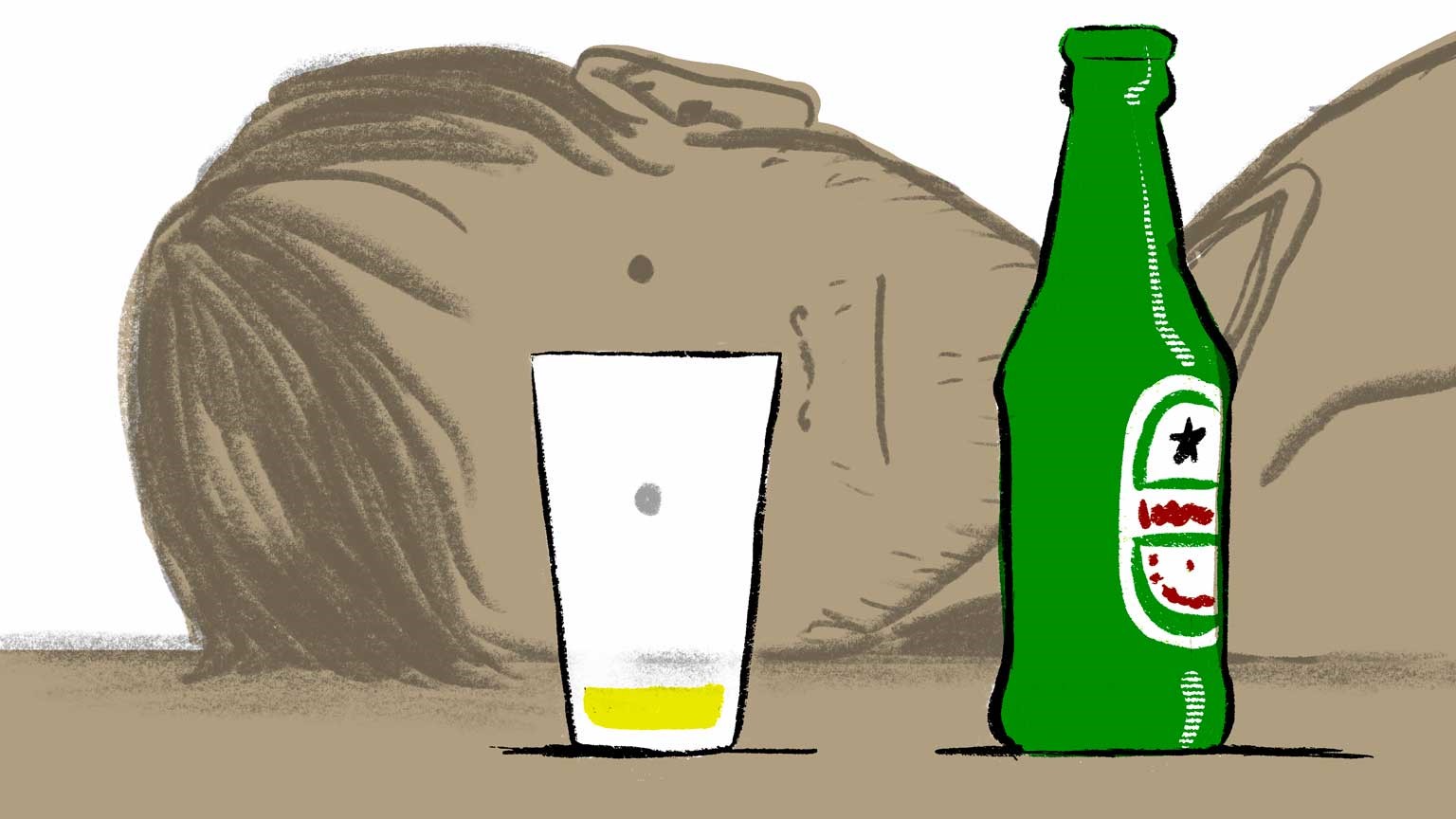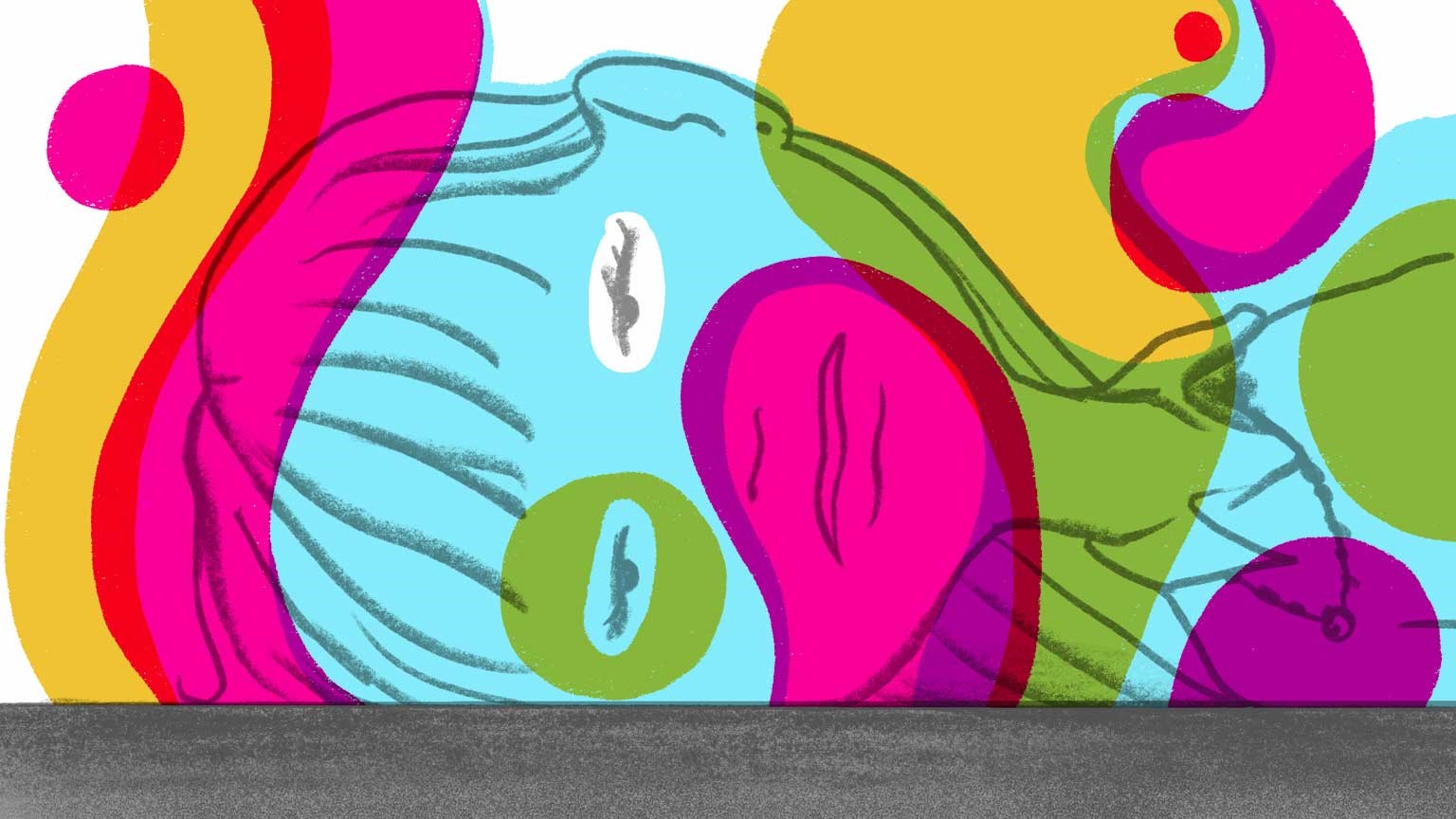Who becomes addicted and who doesn’t? The addicted brain is still a mystery
-
 Illustration: Roel Venderbosch
Illustration: Roel Venderbosch
A recent study by Vox revealed that students are big users of both alcohol and drugs. How great is the risk of addiction? And how does that work in our brains? ‘Heredity plays a major role until you turn twenty-five.’
‘Students are just like people when it comes to addictions,’ Arnt Schellekens jokes. As Professor of Addiction and Psychiatry, and in his work as psychiatrist at the Radboudumc, he regularly sees people with drug or alcohol problems. And yes, some of them are students. It’s a phenomenon that appears in every layer of society, whatever biases there may be. ‘There are lawyers, politicians, high-level athletes and doctors in my professional field who are addicted,’ the professor explains.
‘Students distinguish themselves from the rest of the population by using more, on average,’ says Schellekens. A study by Vox among 670 Radboud students confirms this. It shows that before the outbreak of COVID-19, around 40% of the students drank alcohol multiple days a week. And the majority – six out of every ten students – also uses drugs sometimes.
Vox found that in general, students have reduced their use of alcohol and drugs during the corona crisis. But there is a minority that increased their use, in both drugs and alcohol. In fact, the group using drugs daily doubled, from 2.2 to 4.3%.
The question is, how serious is that? When do you define someone as being addicted? And what makes one person more susceptible to a drug or alcohol problem than another?
In the brain
Addiction is often measured by the number of measures of alcohol a person drinks every week, or how often a person lights up a joint. But according to addiction researcher Maartje Luijten at the Behavioural Science Institute, two criteria have to be met before you can describe your consumption of drugs or alcohol as an addiction.
‘In the case of addiction, there is an element of loss of control, and the use has to impede a person’s daily activities,’ she says. ‘So a person’s study, work or social life suffers as a result. And when someone with an addiction resolves not to drink or use drugs, they always do in the end.’
‘When you take drugs frequently, the interaction between the reward and control systems becomes unbalanced’
Luijten mainly looks at the neurocognitive aspects of addiction; how it works in the brain. According to her, two systems in the brain play a part in any addiction, whether it concerns drugs, alcohol, smoking or sex. The first is the control system or impulse control which is a function of the prefrontal cortex in the brain. The second is the reward system or gratification which is regulated in the nucleus accumbens.
‘The reward system responds to certain stimuli, such as seeing others use, and generates craving,’ says Luijten. Subsequently, the question is whether or not the control system is strong enough to resist that pill, joint or beer. ‘The reward region also stimulates the release of dopamine after the use of, for example, drugs or alcohol,’ Luiten explains.
In itself, that is a perfectly natural and healthy mechanism. ‘The reward system makes sure that people are motivated to look for food or procreate,’ says Luijten. ‘That helps us survive and is not problematic.’ The problems occur because substances such as alcohol or drugs have a much stronger effect than natural rewards such as sex or food. Luijten: ‘When you use a lot of alcohol or drugs, the interaction between the reward and control systems becomes increasingly unbalanced.’
Vulnerable group
And that’s where the danger of frequently drinking a beer or smoking a joint lies. ‘Frequent use can result in the formation of habits,’ says Roy Otten, Professor of Clinical Developmental Psychology. He is researching the factors that contribute to substance use in young people. ‘Those habits then contribute to the risk of problem use and addiction,’ he says.
Does it make any difference how young you are when you start smoking or drinking? Schellekens, the psychiatrist, says it does. ‘The younger the age at which someone starts drinking, the greater the risk of alcohol addiction. That effect declines with age: the difference between starting drinking when you’re twenty or twenty-one is not as great as it is between thirteen and fourteen.’ The brain that has still to develop is quite simply vulnerable, according to Schellekens.
‘When the brain has matured more, when you’re around twenty-five, and you’ve got your life sorted, the chances of your alcohol use getting out of hand are smaller. Before that age, hereditary factors play a greater role. After that, environment and experiences become more important, unpleasant occurrences for example, or losing a loved one.’
However, by far the majority of students just use a pill or a drink for social reasons, according to Professor Otten. The fact that the largest group in the Vox survey uses much less at present is absolutely to be expected. The pubs are shut and parties are forbidden so there’s much less alcohol being drunk and far fewer party drugs such as XTC being used.
‘You have a group that was already vulnerable, and that vulnerability might increase now’
And what about the small minority that is using more now than before the crisis? ‘I can imagine that students who were already accustomed to sitting alone at home, drinking a lot and using drugs, are doing that even more now,’ says Otten. He’s referring to young people who use alcohol or drugs as a coping mechanism. ‘You have a group that was already vulnerable, and that vulnerability might increase now. It’s essential that we identify that group.’
Perfect storm
However, corona circumstances alone don’t make people addicted. ‘It takes more than that,’ says Otten. ‘You might see addiction as a kind of perfect storm in which multiple variables, risk factors, come together at a certain point.’
What makes the storm? Why does one person become addicted and another doesn’t? ‘Hmm, if only we knew,’ says Schellekens. Biological, psychological and social factors all play a part in addiction. ‘And each factor contributes substantially,’ says the professor.
‘For example, research has shown that heredity contributes between 50 and 60% to the risk of developing an addiction.’ But you can’t just fit every addicted individual into that mould. ‘There are a great many genes which contribute a little and it varies from one individual to another. One person doesn’t have the genes but does develop an addiction while another person has a family full of addicts but the person themself is unaffected.’
‘Draw up an individual risk profile and make predictions on that basis? We’re not able to do that yet’
And sometimes psychological factors or social circumstances are more likely to have played a role, according to Schellekens. Or both. ‘Social factors such as having nice friends, a great relationship or a good job are difficult to summarise in figures,’ he says. ‘That makes addiction more difficult to research sometimes than other sorts of physical disorders.’
‘At a group level, it’s possible to identify some things that contribute to the susceptibility to developing an addiction,’ says Schellekens. Such as those hereditary factors, mood disorders or traumas. ‘But translating this into an individual risk profile and making predictions on that basis is not something we are able to do yet.’
Predicting
How is it possible that we still actually know very little about addiction and why is predicting so difficult? After all, as behavioural scientist Luijten says, brain research into addiction began in the mid-1990s. ‘However, at that time, they worked with very small groups of test subjects with a great many contradictory findings as the result.’
In her own research into nicotine addiction among young people, Luijten therefore tried to increase the size of the research group. She measured the brains of a hundred young people who experimented with smoking, known as ‘high-risk youth’ and fifty non-smokers. She screened around ten thousand young people, just to find exactly the right participants. ‘It was hell,’ she laughs.
‘Students still have their whole lives before them’
Comparing an addicted brain with one that wasn’t addicted turned out to be more difficult than anticipated. ‘Many non-smokers can display the same brain activity as the smokers and vice versa,’ Luijten explains. However, she did find that in general, the control system in the brain appeared to be less active in the brains of the high-risk young people.
And to complicate matters even more, it’s sometimes better to look at the individual, according to Otten. ‘Large-scale studies into alcohol use, such as that of Vox, are important to reveal certain mechanisms but they’re based on averages and therefore say nothing about the individual. What you actually want to know is whether that one person who often uses cocaine anyway has started using more and why.’
New predictive techniques such as machine learning may well contribute to research into addiction at some point, according to Schellekens. ‘Through machine learning, computers can generate new mathematical models that gather together all predictive factors of addiction.’ The technique is new to science, as recent as ten years. The method has already been used in the prediction of psychosis, but the predictions were not always better than those a doctor would make.
And in the end, in order to treat someone’s addiction, you have to look really closely at their personal circumstances, according to Schellekens. ‘In that sense, students are often at an advantage if they are treated for an addiction,’ the psychiatrist adds. ‘In general, they’re young and intelligent. You can make use of that as a practitioner. They still have their whole lives before them.’




